Economics Assignment: Decision-Making Principles and Applications
VerifiedAdded on 2023/06/09
|16
|1984
|475
Homework Assignment
AI Summary
This economics assignment provides a comprehensive analysis of decision-making principles, covering topics such as opportunity cost, production possibilities, market equilibrium, consumer and producer surplus, and elasticity of demand. It includes detailed explanations and graphical representations to illustrate key concepts. The assignment also addresses the impact of taxes on market dynamics and differentiates between positive and normative statements in economic analysis. Furthermore, it explores the concept of diminishing returns and its implications for production decisions. Desklib provides students access to this assignment along with a wealth of other study resources, including past papers and solved assignments, to enhance their understanding of economics.
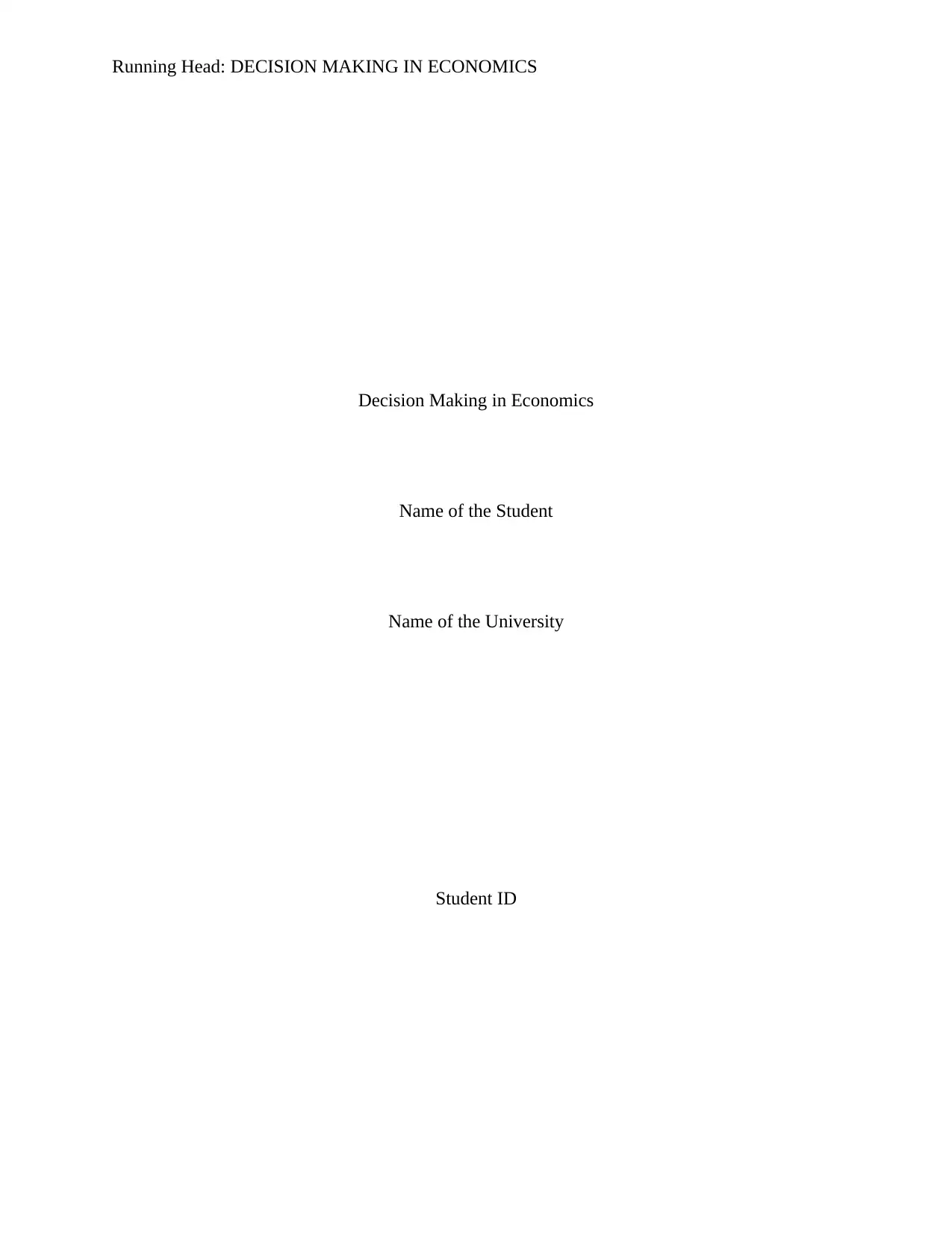
Running Head: DECISION MAKING IN ECONOMICS
Decision Making in Economics
Name of the Student
Name of the University
Student ID
Decision Making in Economics
Name of the Student
Name of the University
Student ID
Paraphrase This Document
Need a fresh take? Get an instant paraphrase of this document with our AI Paraphraser
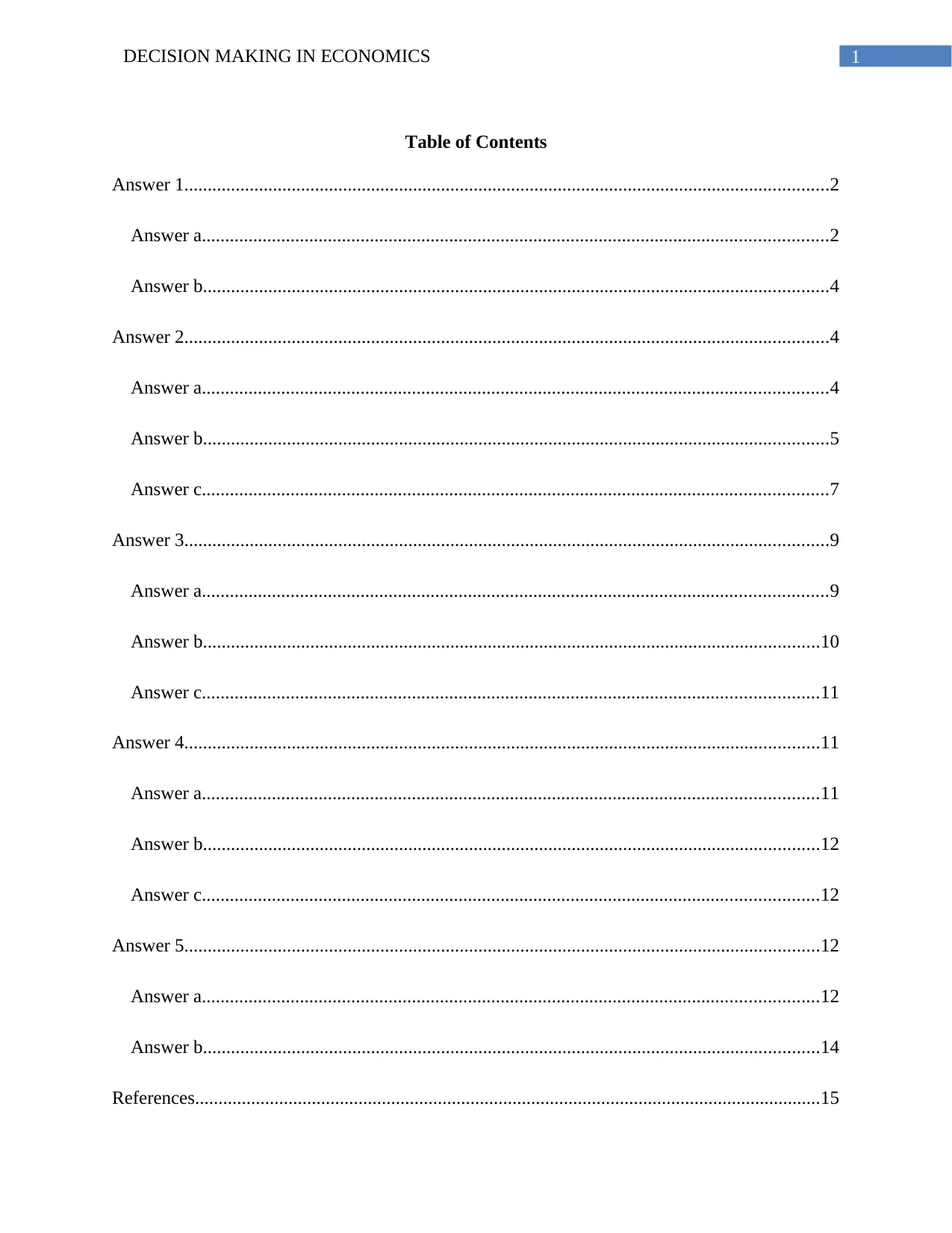
1DECISION MAKING IN ECONOMICS
Table of Contents
Answer 1..........................................................................................................................................2
Answer a......................................................................................................................................2
Answer b......................................................................................................................................4
Answer 2..........................................................................................................................................4
Answer a......................................................................................................................................4
Answer b......................................................................................................................................5
Answer c......................................................................................................................................7
Answer 3..........................................................................................................................................9
Answer a......................................................................................................................................9
Answer b....................................................................................................................................10
Answer c....................................................................................................................................11
Answer 4........................................................................................................................................11
Answer a....................................................................................................................................11
Answer b....................................................................................................................................12
Answer c....................................................................................................................................12
Answer 5........................................................................................................................................12
Answer a....................................................................................................................................12
Answer b....................................................................................................................................14
References......................................................................................................................................15
Table of Contents
Answer 1..........................................................................................................................................2
Answer a......................................................................................................................................2
Answer b......................................................................................................................................4
Answer 2..........................................................................................................................................4
Answer a......................................................................................................................................4
Answer b......................................................................................................................................5
Answer c......................................................................................................................................7
Answer 3..........................................................................................................................................9
Answer a......................................................................................................................................9
Answer b....................................................................................................................................10
Answer c....................................................................................................................................11
Answer 4........................................................................................................................................11
Answer a....................................................................................................................................11
Answer b....................................................................................................................................12
Answer c....................................................................................................................................12
Answer 5........................................................................................................................................12
Answer a....................................................................................................................................12
Answer b....................................................................................................................................14
References......................................................................................................................................15
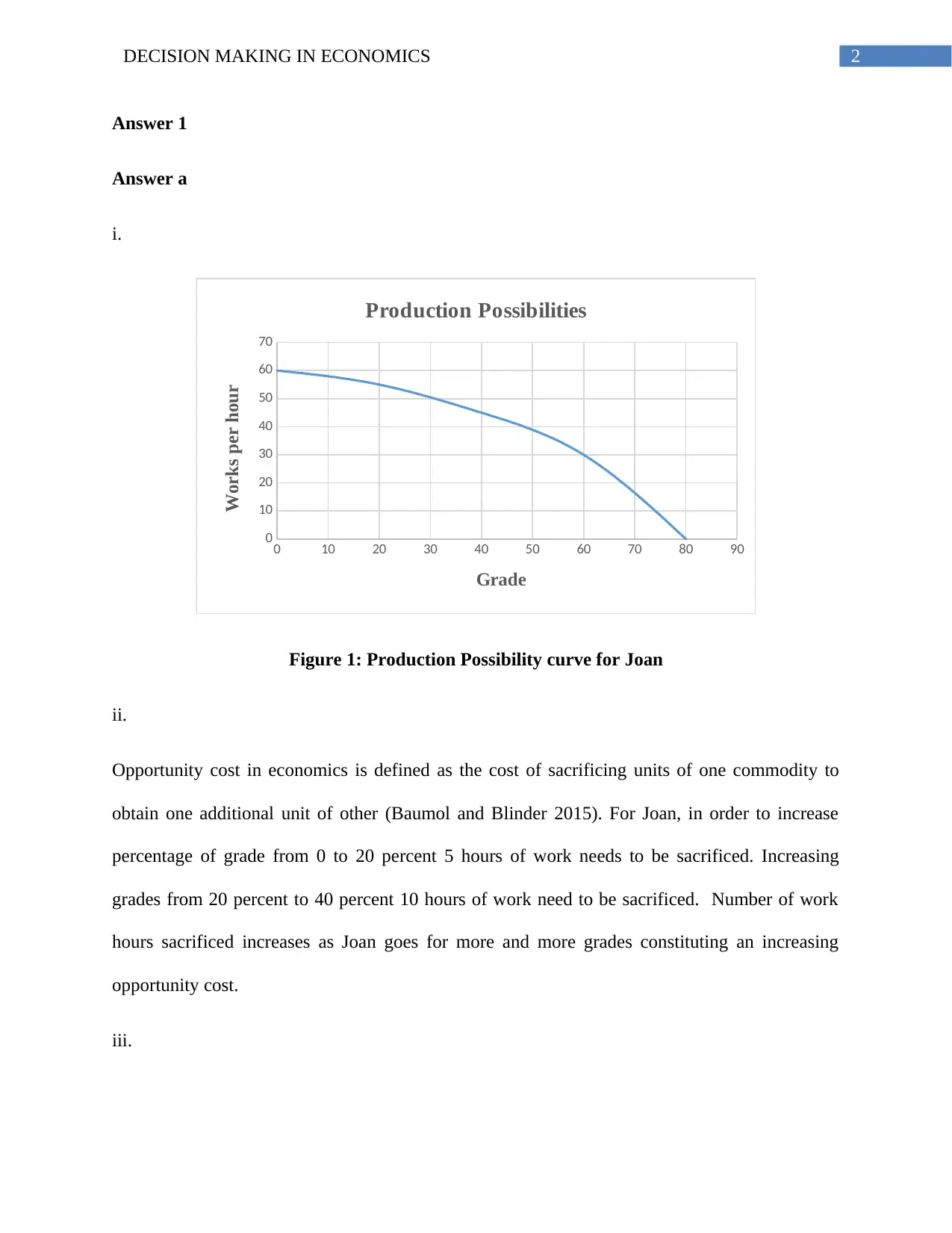
2DECISION MAKING IN ECONOMICS
Answer 1
Answer a
i.
0 10 20 30 40 50 60 70 80 90
0
10
20
30
40
50
60
70
Production Possibilities
Grade
Works per hour
Figure 1: Production Possibility curve for Joan
ii.
Opportunity cost in economics is defined as the cost of sacrificing units of one commodity to
obtain one additional unit of other (Baumol and Blinder 2015). For Joan, in order to increase
percentage of grade from 0 to 20 percent 5 hours of work needs to be sacrificed. Increasing
grades from 20 percent to 40 percent 10 hours of work need to be sacrificed. Number of work
hours sacrificed increases as Joan goes for more and more grades constituting an increasing
opportunity cost.
iii.
Answer 1
Answer a
i.
0 10 20 30 40 50 60 70 80 90
0
10
20
30
40
50
60
70
Production Possibilities
Grade
Works per hour
Figure 1: Production Possibility curve for Joan
ii.
Opportunity cost in economics is defined as the cost of sacrificing units of one commodity to
obtain one additional unit of other (Baumol and Blinder 2015). For Joan, in order to increase
percentage of grade from 0 to 20 percent 5 hours of work needs to be sacrificed. Increasing
grades from 20 percent to 40 percent 10 hours of work need to be sacrificed. Number of work
hours sacrificed increases as Joan goes for more and more grades constituting an increasing
opportunity cost.
iii.
⊘ This is a preview!⊘
Do you want full access?
Subscribe today to unlock all pages.

Trusted by 1+ million students worldwide
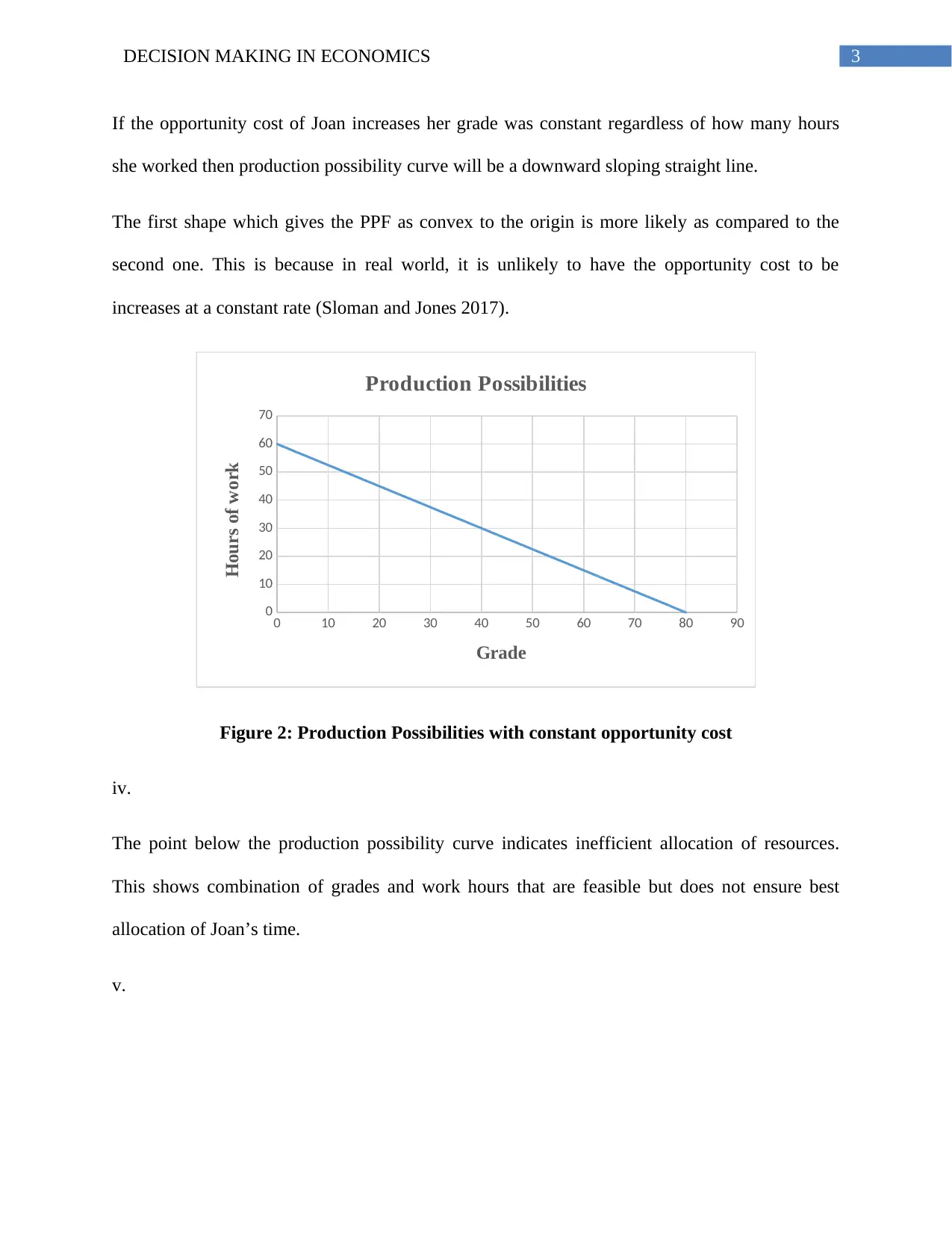
3DECISION MAKING IN ECONOMICS
If the opportunity cost of Joan increases her grade was constant regardless of how many hours
she worked then production possibility curve will be a downward sloping straight line.
The first shape which gives the PPF as convex to the origin is more likely as compared to the
second one. This is because in real world, it is unlikely to have the opportunity cost to be
increases at a constant rate (Sloman and Jones 2017).
0 10 20 30 40 50 60 70 80 90
0
10
20
30
40
50
60
70
Production Possibilities
Grade
Hours of work
Figure 2: Production Possibilities with constant opportunity cost
iv.
The point below the production possibility curve indicates inefficient allocation of resources.
This shows combination of grades and work hours that are feasible but does not ensure best
allocation of Joan’s time.
v.
If the opportunity cost of Joan increases her grade was constant regardless of how many hours
she worked then production possibility curve will be a downward sloping straight line.
The first shape which gives the PPF as convex to the origin is more likely as compared to the
second one. This is because in real world, it is unlikely to have the opportunity cost to be
increases at a constant rate (Sloman and Jones 2017).
0 10 20 30 40 50 60 70 80 90
0
10
20
30
40
50
60
70
Production Possibilities
Grade
Hours of work
Figure 2: Production Possibilities with constant opportunity cost
iv.
The point below the production possibility curve indicates inefficient allocation of resources.
This shows combination of grades and work hours that are feasible but does not ensure best
allocation of Joan’s time.
v.
Paraphrase This Document
Need a fresh take? Get an instant paraphrase of this document with our AI Paraphraser
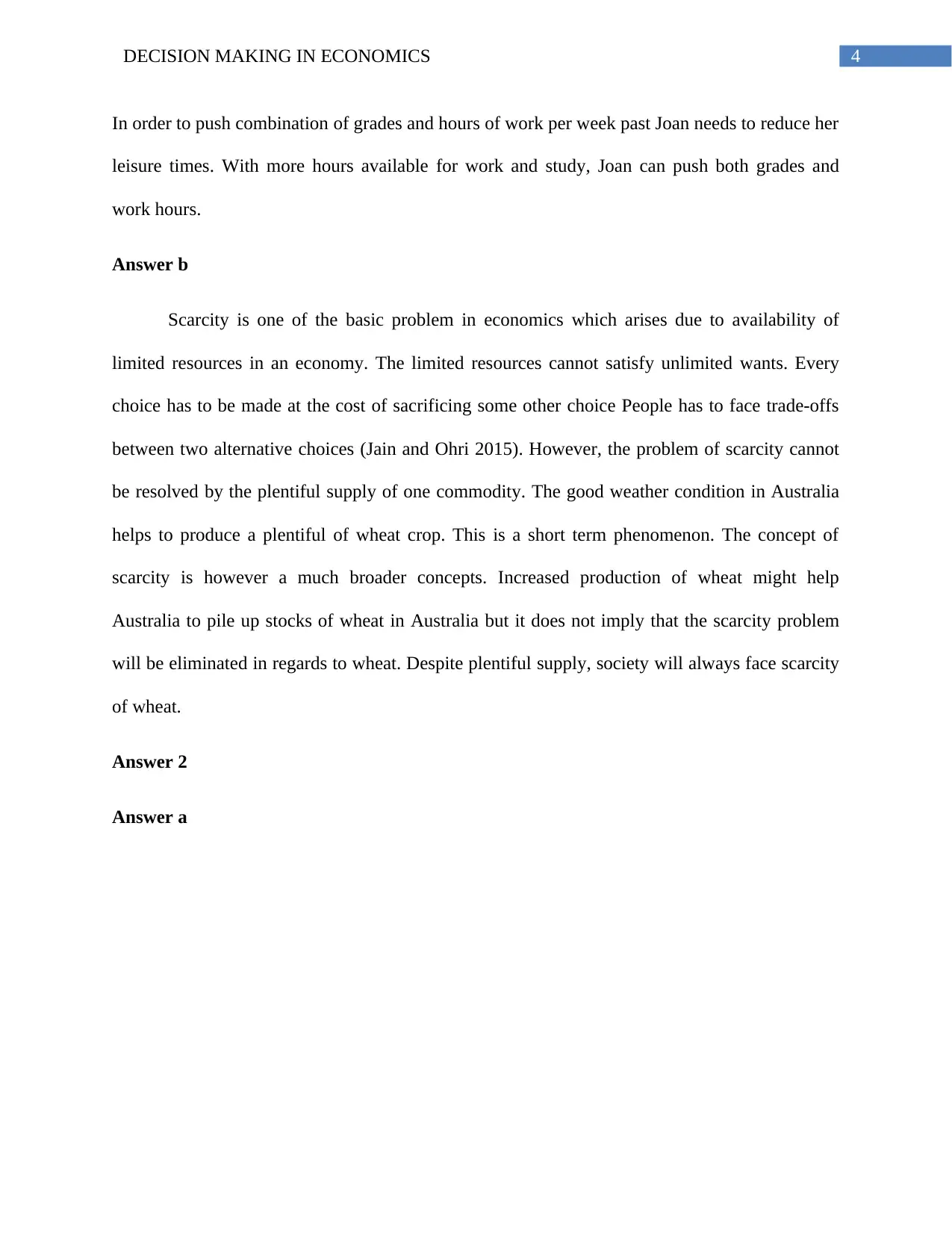
4DECISION MAKING IN ECONOMICS
In order to push combination of grades and hours of work per week past Joan needs to reduce her
leisure times. With more hours available for work and study, Joan can push both grades and
work hours.
Answer b
Scarcity is one of the basic problem in economics which arises due to availability of
limited resources in an economy. The limited resources cannot satisfy unlimited wants. Every
choice has to be made at the cost of sacrificing some other choice People has to face trade-offs
between two alternative choices (Jain and Ohri 2015). However, the problem of scarcity cannot
be resolved by the plentiful supply of one commodity. The good weather condition in Australia
helps to produce a plentiful of wheat crop. This is a short term phenomenon. The concept of
scarcity is however a much broader concepts. Increased production of wheat might help
Australia to pile up stocks of wheat in Australia but it does not imply that the scarcity problem
will be eliminated in regards to wheat. Despite plentiful supply, society will always face scarcity
of wheat.
Answer 2
Answer a
In order to push combination of grades and hours of work per week past Joan needs to reduce her
leisure times. With more hours available for work and study, Joan can push both grades and
work hours.
Answer b
Scarcity is one of the basic problem in economics which arises due to availability of
limited resources in an economy. The limited resources cannot satisfy unlimited wants. Every
choice has to be made at the cost of sacrificing some other choice People has to face trade-offs
between two alternative choices (Jain and Ohri 2015). However, the problem of scarcity cannot
be resolved by the plentiful supply of one commodity. The good weather condition in Australia
helps to produce a plentiful of wheat crop. This is a short term phenomenon. The concept of
scarcity is however a much broader concepts. Increased production of wheat might help
Australia to pile up stocks of wheat in Australia but it does not imply that the scarcity problem
will be eliminated in regards to wheat. Despite plentiful supply, society will always face scarcity
of wheat.
Answer 2
Answer a
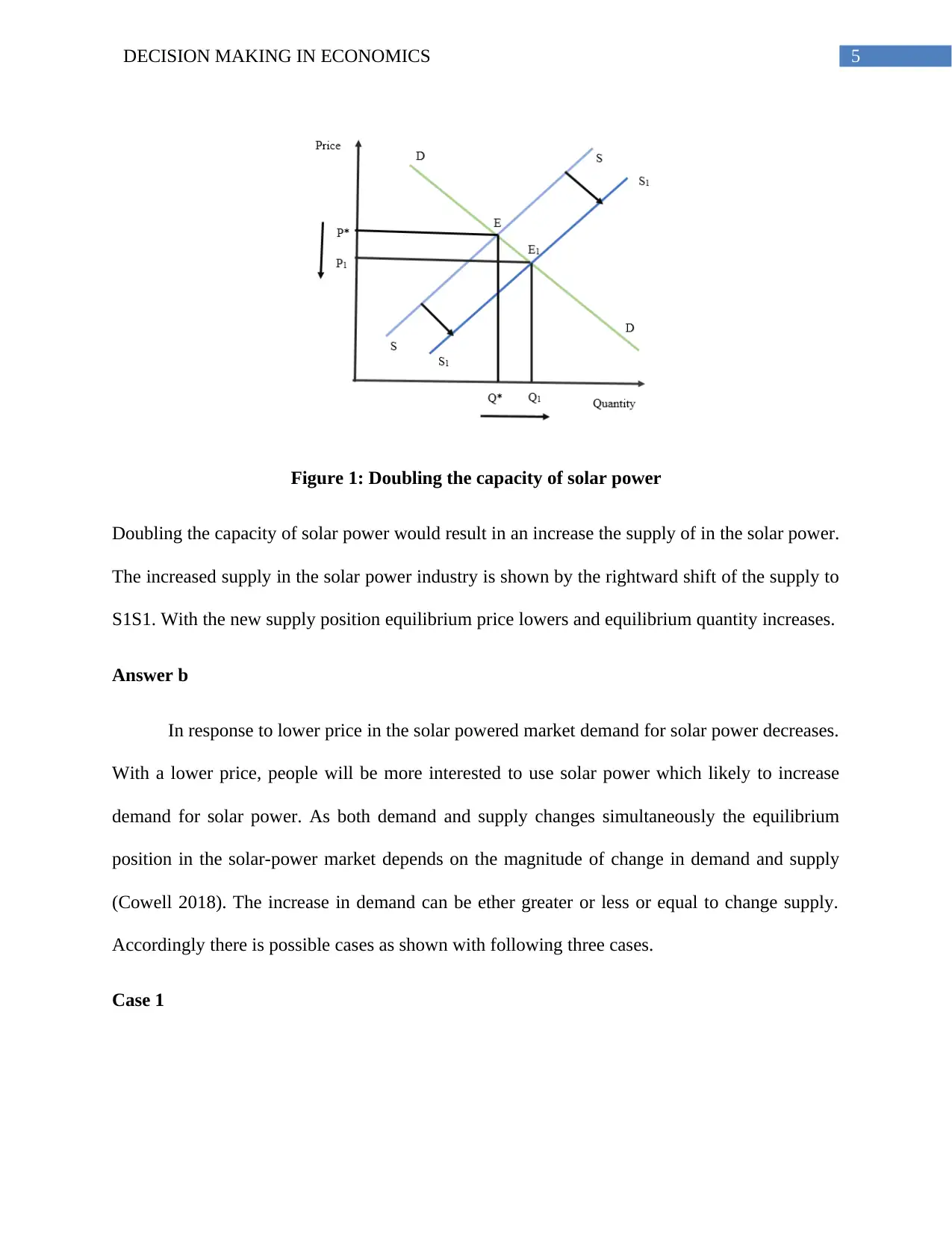
5DECISION MAKING IN ECONOMICS
Figure 1: Doubling the capacity of solar power
Doubling the capacity of solar power would result in an increase the supply of in the solar power.
The increased supply in the solar power industry is shown by the rightward shift of the supply to
S1S1. With the new supply position equilibrium price lowers and equilibrium quantity increases.
Answer b
In response to lower price in the solar powered market demand for solar power decreases.
With a lower price, people will be more interested to use solar power which likely to increase
demand for solar power. As both demand and supply changes simultaneously the equilibrium
position in the solar-power market depends on the magnitude of change in demand and supply
(Cowell 2018). The increase in demand can be ether greater or less or equal to change supply.
Accordingly there is possible cases as shown with following three cases.
Case 1
Figure 1: Doubling the capacity of solar power
Doubling the capacity of solar power would result in an increase the supply of in the solar power.
The increased supply in the solar power industry is shown by the rightward shift of the supply to
S1S1. With the new supply position equilibrium price lowers and equilibrium quantity increases.
Answer b
In response to lower price in the solar powered market demand for solar power decreases.
With a lower price, people will be more interested to use solar power which likely to increase
demand for solar power. As both demand and supply changes simultaneously the equilibrium
position in the solar-power market depends on the magnitude of change in demand and supply
(Cowell 2018). The increase in demand can be ether greater or less or equal to change supply.
Accordingly there is possible cases as shown with following three cases.
Case 1
⊘ This is a preview!⊘
Do you want full access?
Subscribe today to unlock all pages.

Trusted by 1+ million students worldwide
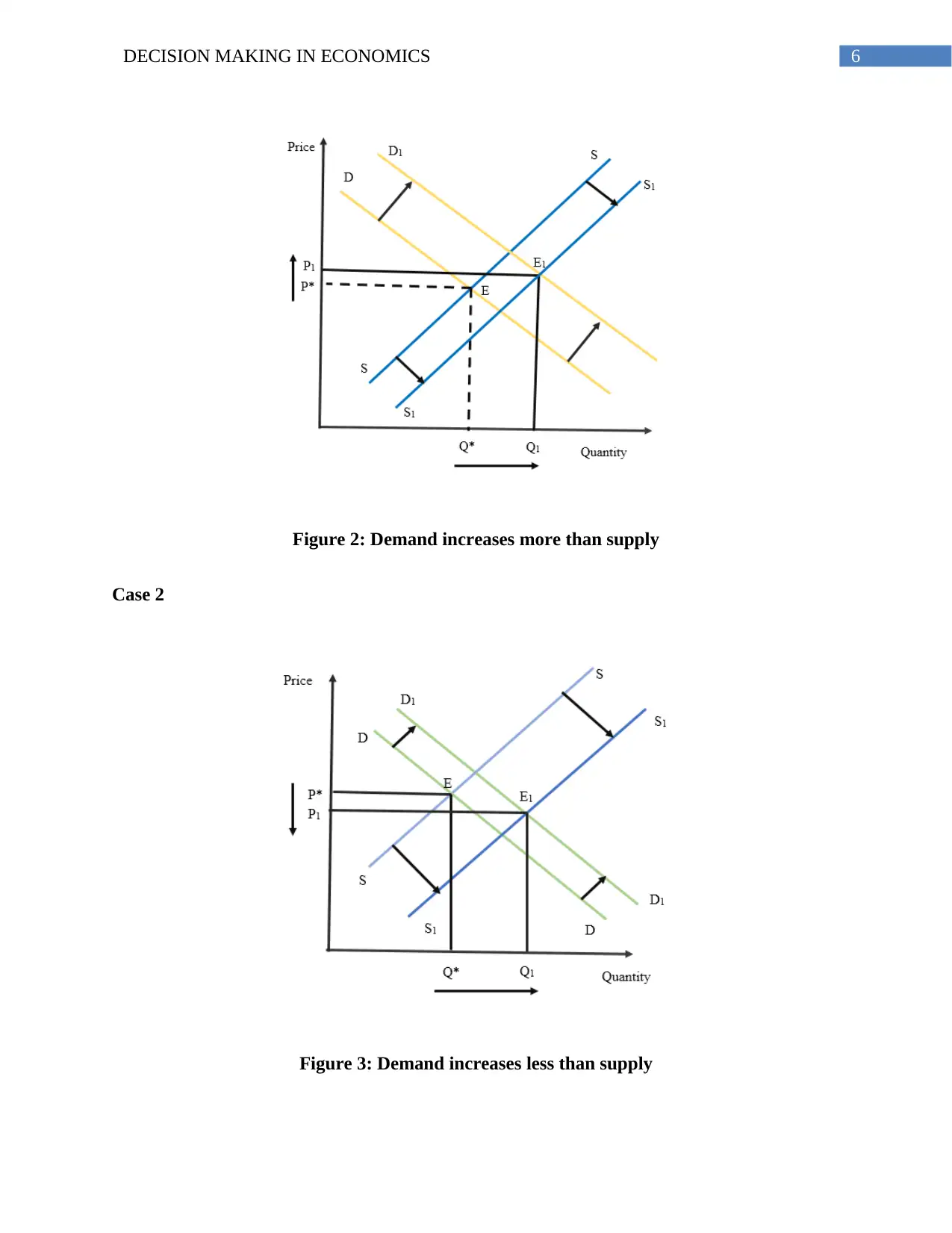
6DECISION MAKING IN ECONOMICS
Figure 2: Demand increases more than supply
Case 2
Figure 3: Demand increases less than supply
Figure 2: Demand increases more than supply
Case 2
Figure 3: Demand increases less than supply
Paraphrase This Document
Need a fresh take? Get an instant paraphrase of this document with our AI Paraphraser
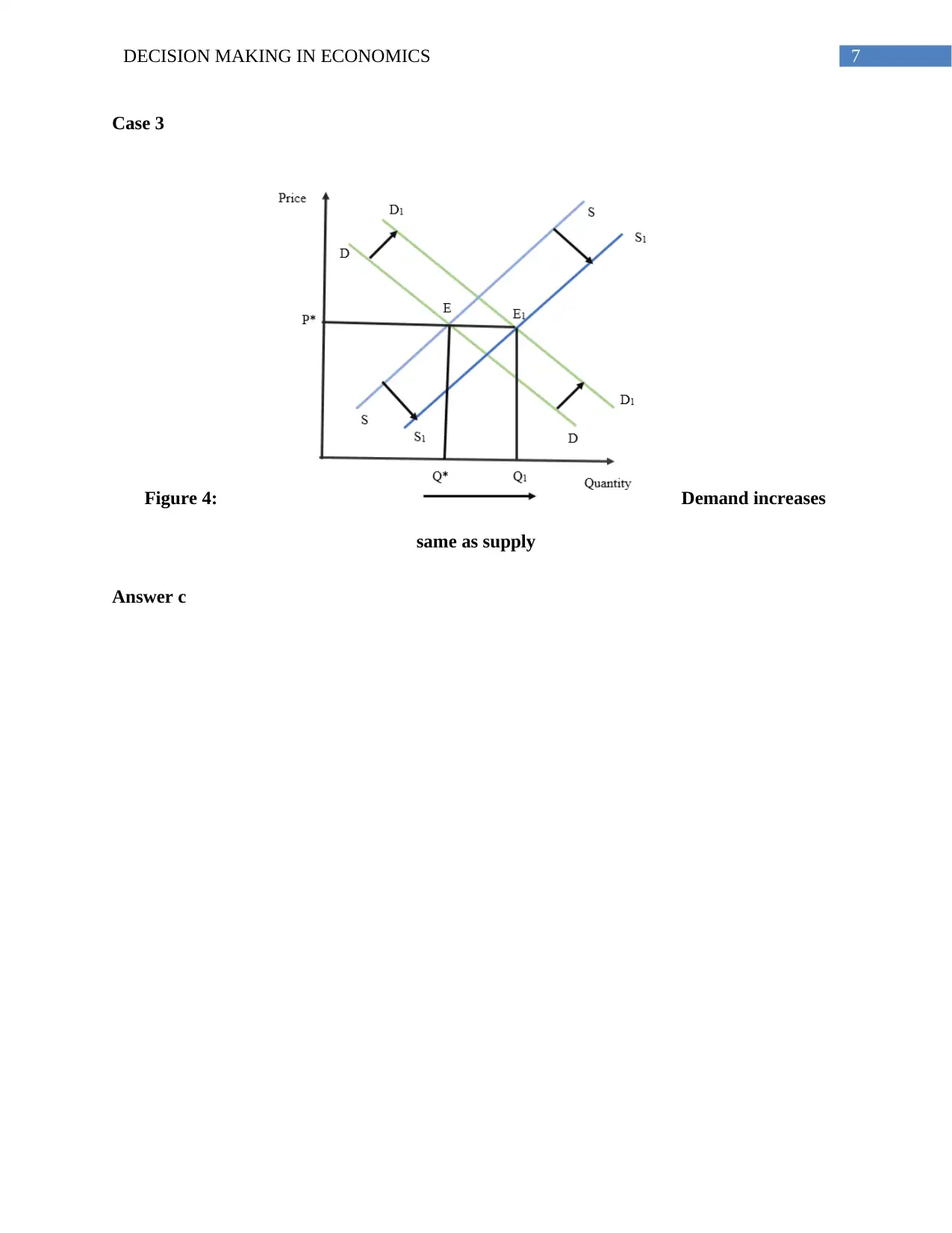
7DECISION MAKING IN ECONOMICS
Case 3
Figure 4: Demand increases
same as supply
Answer c
Case 3
Figure 4: Demand increases
same as supply
Answer c
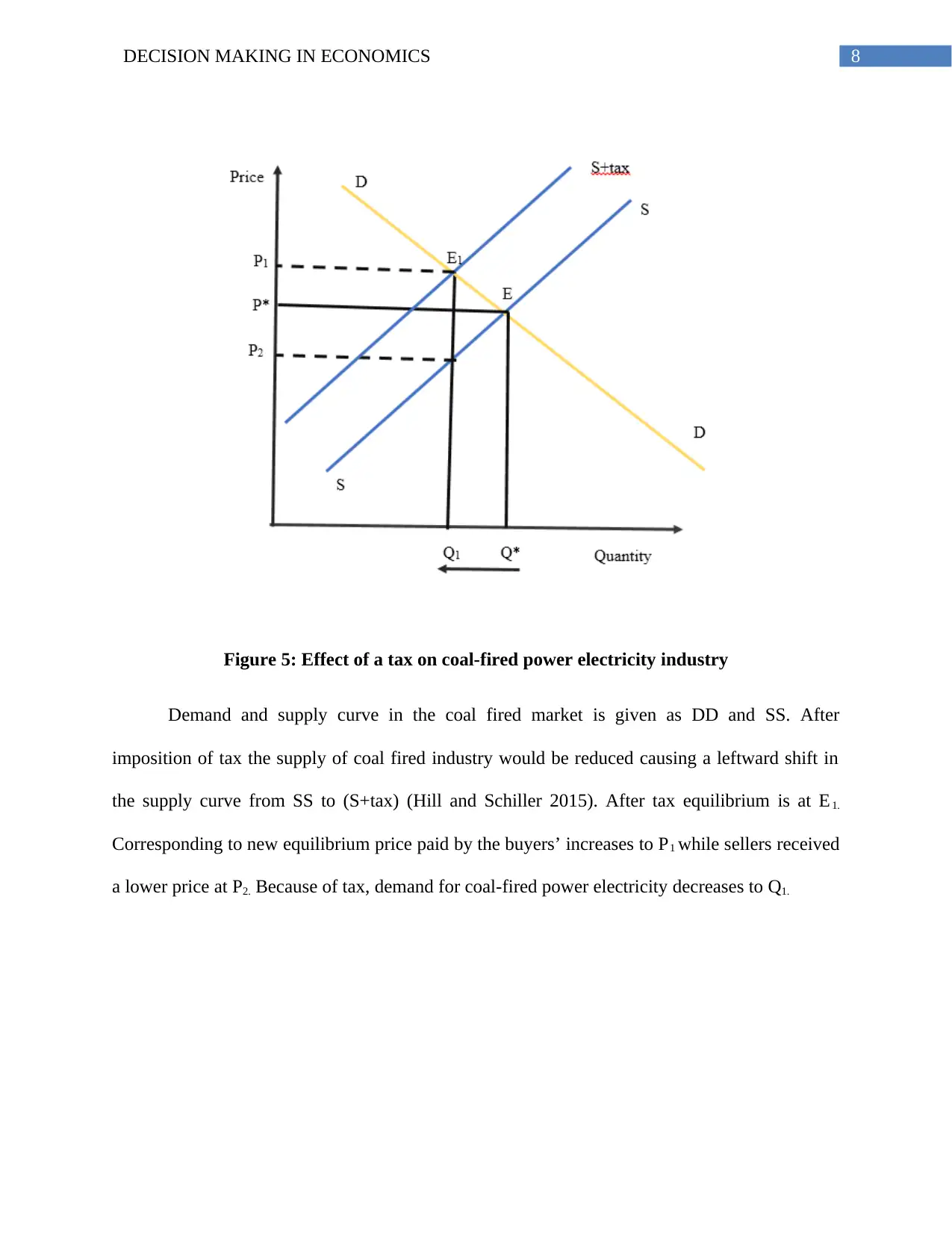
8DECISION MAKING IN ECONOMICS
Figure 5: Effect of a tax on coal-fired power electricity industry
Demand and supply curve in the coal fired market is given as DD and SS. After
imposition of tax the supply of coal fired industry would be reduced causing a leftward shift in
the supply curve from SS to (S+tax) (Hill and Schiller 2015). After tax equilibrium is at E1.
Corresponding to new equilibrium price paid by the buyers’ increases to P1 while sellers received
a lower price at P2. Because of tax, demand for coal-fired power electricity decreases to Q1.
Figure 5: Effect of a tax on coal-fired power electricity industry
Demand and supply curve in the coal fired market is given as DD and SS. After
imposition of tax the supply of coal fired industry would be reduced causing a leftward shift in
the supply curve from SS to (S+tax) (Hill and Schiller 2015). After tax equilibrium is at E1.
Corresponding to new equilibrium price paid by the buyers’ increases to P1 while sellers received
a lower price at P2. Because of tax, demand for coal-fired power electricity decreases to Q1.
⊘ This is a preview!⊘
Do you want full access?
Subscribe today to unlock all pages.

Trusted by 1+ million students worldwide
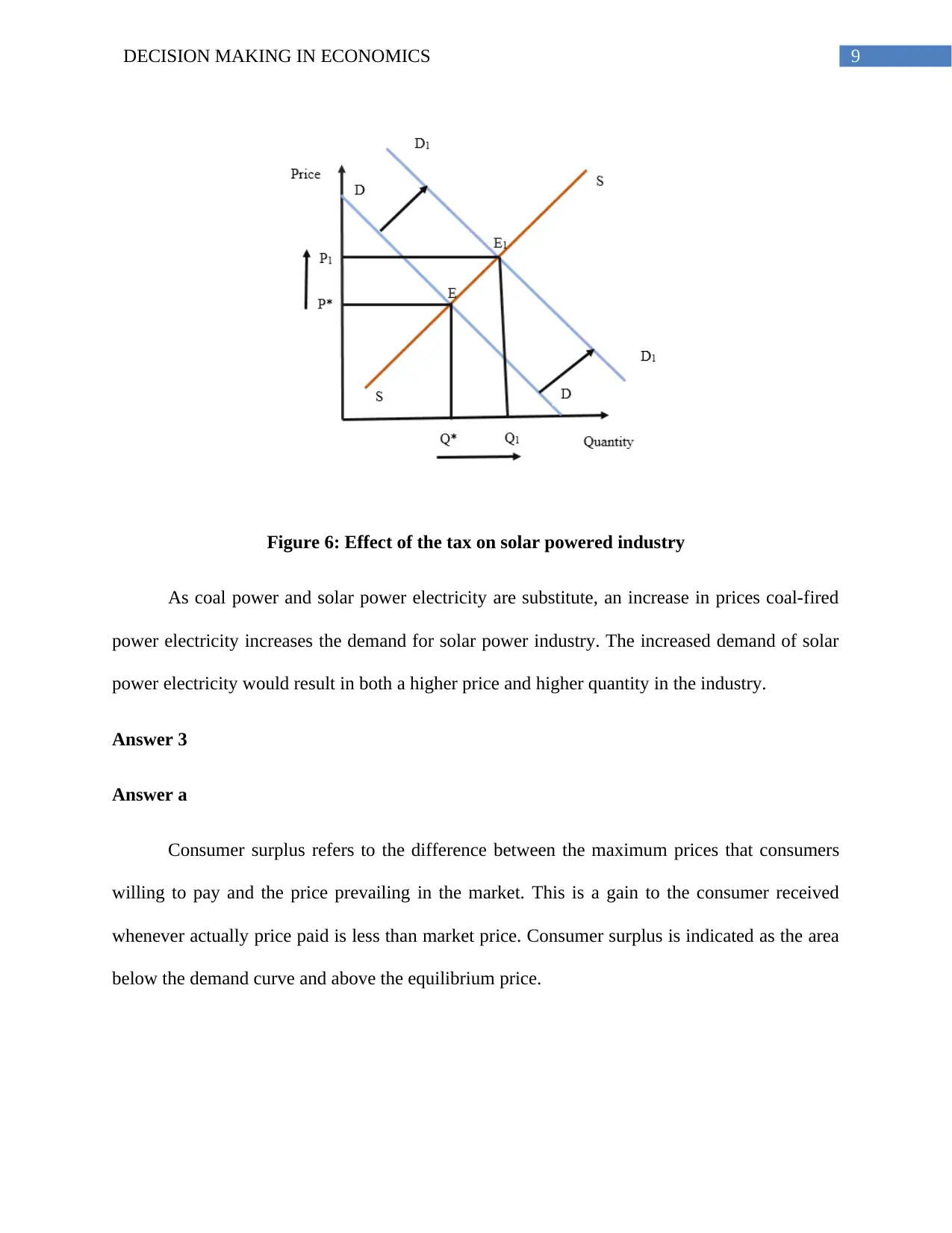
9DECISION MAKING IN ECONOMICS
Figure 6: Effect of the tax on solar powered industry
As coal power and solar power electricity are substitute, an increase in prices coal-fired
power electricity increases the demand for solar power industry. The increased demand of solar
power electricity would result in both a higher price and higher quantity in the industry.
Answer 3
Answer a
Consumer surplus refers to the difference between the maximum prices that consumers
willing to pay and the price prevailing in the market. This is a gain to the consumer received
whenever actually price paid is less than market price. Consumer surplus is indicated as the area
below the demand curve and above the equilibrium price.
Figure 6: Effect of the tax on solar powered industry
As coal power and solar power electricity are substitute, an increase in prices coal-fired
power electricity increases the demand for solar power industry. The increased demand of solar
power electricity would result in both a higher price and higher quantity in the industry.
Answer 3
Answer a
Consumer surplus refers to the difference between the maximum prices that consumers
willing to pay and the price prevailing in the market. This is a gain to the consumer received
whenever actually price paid is less than market price. Consumer surplus is indicated as the area
below the demand curve and above the equilibrium price.
Paraphrase This Document
Need a fresh take? Get an instant paraphrase of this document with our AI Paraphraser
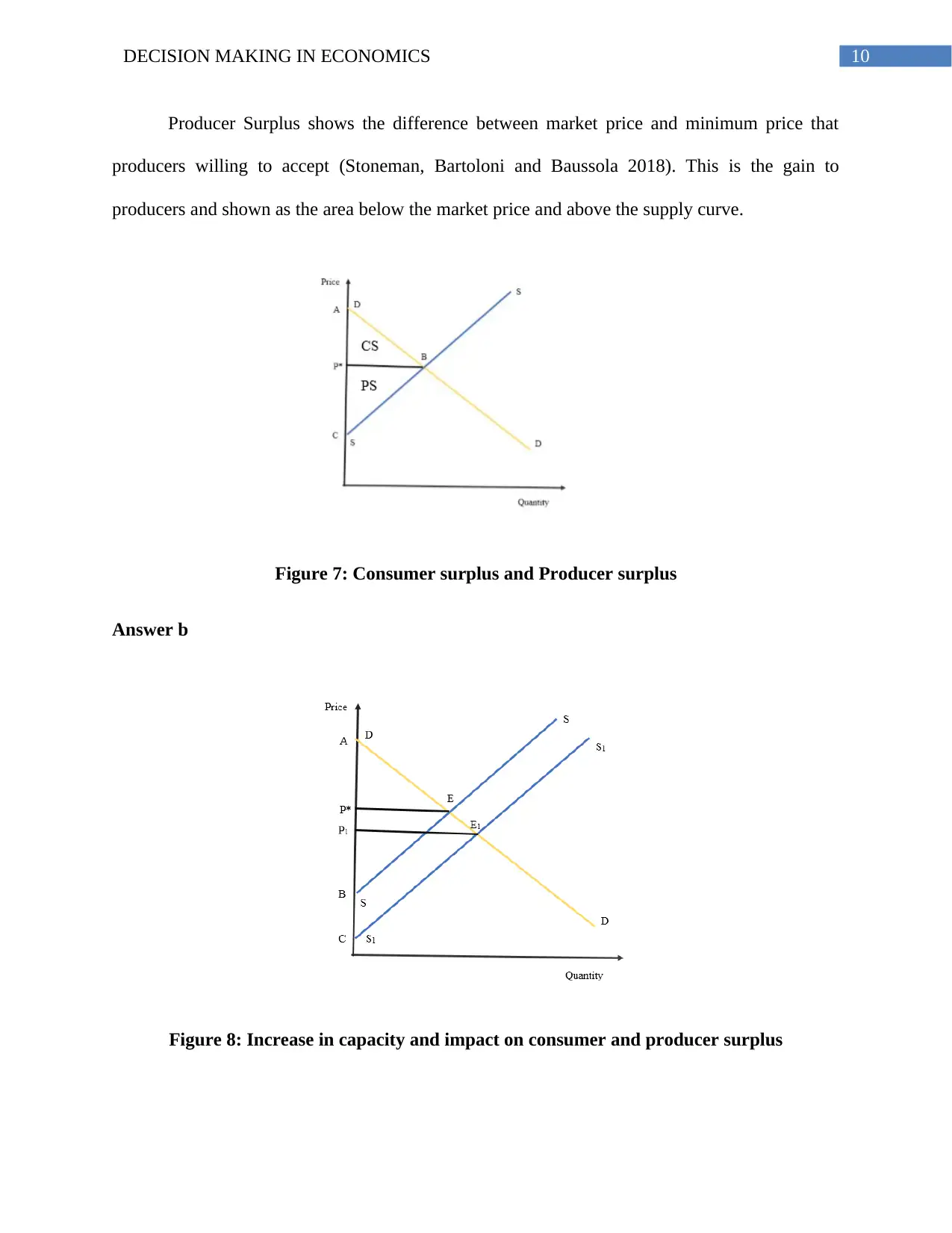
10DECISION MAKING IN ECONOMICS
Producer Surplus shows the difference between market price and minimum price that
producers willing to accept (Stoneman, Bartoloni and Baussola 2018). This is the gain to
producers and shown as the area below the market price and above the supply curve.
Figure 7: Consumer surplus and Producer surplus
Answer b
Figure 8: Increase in capacity and impact on consumer and producer surplus
Producer Surplus shows the difference between market price and minimum price that
producers willing to accept (Stoneman, Bartoloni and Baussola 2018). This is the gain to
producers and shown as the area below the market price and above the supply curve.
Figure 7: Consumer surplus and Producer surplus
Answer b
Figure 8: Increase in capacity and impact on consumer and producer surplus
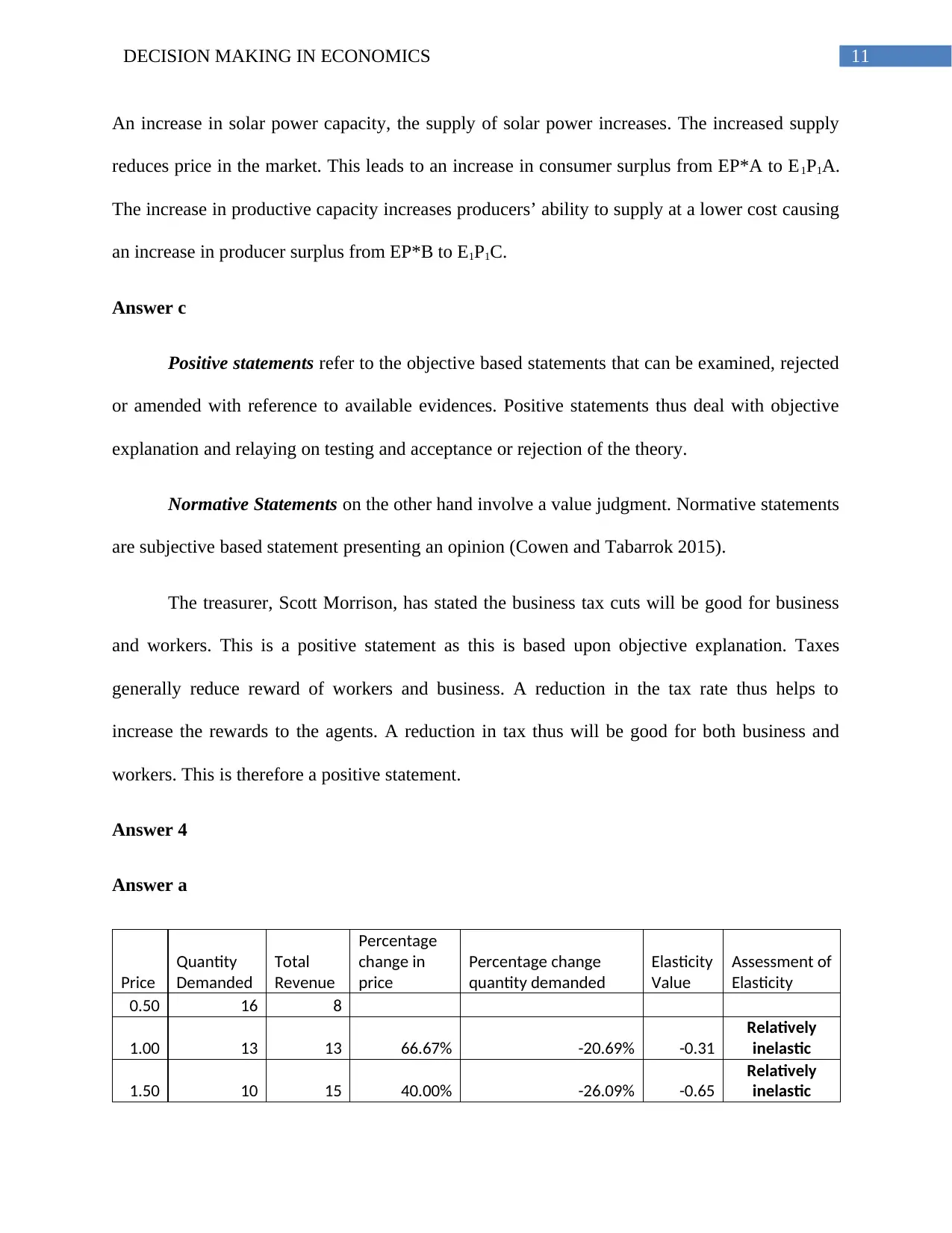
11DECISION MAKING IN ECONOMICS
An increase in solar power capacity, the supply of solar power increases. The increased supply
reduces price in the market. This leads to an increase in consumer surplus from EP*A to E1P1A.
The increase in productive capacity increases producers’ ability to supply at a lower cost causing
an increase in producer surplus from EP*B to E1P1C.
Answer c
Positive statements refer to the objective based statements that can be examined, rejected
or amended with reference to available evidences. Positive statements thus deal with objective
explanation and relaying on testing and acceptance or rejection of the theory.
Normative Statements on the other hand involve a value judgment. Normative statements
are subjective based statement presenting an opinion (Cowen and Tabarrok 2015).
The treasurer, Scott Morrison, has stated the business tax cuts will be good for business
and workers. This is a positive statement as this is based upon objective explanation. Taxes
generally reduce reward of workers and business. A reduction in the tax rate thus helps to
increase the rewards to the agents. A reduction in tax thus will be good for both business and
workers. This is therefore a positive statement.
Answer 4
Answer a
Price
Quantity
Demanded
Total
Revenue
Percentage
change in
price
Percentage change
quantity demanded
Elasticity
Value
Assessment of
Elasticity
0.50 16 8
1.00 13 13 66.67% -20.69% -0.31
Relatively
inelastic
1.50 10 15 40.00% -26.09% -0.65
Relatively
inelastic
An increase in solar power capacity, the supply of solar power increases. The increased supply
reduces price in the market. This leads to an increase in consumer surplus from EP*A to E1P1A.
The increase in productive capacity increases producers’ ability to supply at a lower cost causing
an increase in producer surplus from EP*B to E1P1C.
Answer c
Positive statements refer to the objective based statements that can be examined, rejected
or amended with reference to available evidences. Positive statements thus deal with objective
explanation and relaying on testing and acceptance or rejection of the theory.
Normative Statements on the other hand involve a value judgment. Normative statements
are subjective based statement presenting an opinion (Cowen and Tabarrok 2015).
The treasurer, Scott Morrison, has stated the business tax cuts will be good for business
and workers. This is a positive statement as this is based upon objective explanation. Taxes
generally reduce reward of workers and business. A reduction in the tax rate thus helps to
increase the rewards to the agents. A reduction in tax thus will be good for both business and
workers. This is therefore a positive statement.
Answer 4
Answer a
Price
Quantity
Demanded
Total
Revenue
Percentage
change in
price
Percentage change
quantity demanded
Elasticity
Value
Assessment of
Elasticity
0.50 16 8
1.00 13 13 66.67% -20.69% -0.31
Relatively
inelastic
1.50 10 15 40.00% -26.09% -0.65
Relatively
inelastic
⊘ This is a preview!⊘
Do you want full access?
Subscribe today to unlock all pages.

Trusted by 1+ million students worldwide
1 out of 16
Related Documents
Your All-in-One AI-Powered Toolkit for Academic Success.
+13062052269
info@desklib.com
Available 24*7 on WhatsApp / Email
![[object Object]](/_next/static/media/star-bottom.7253800d.svg)
Unlock your academic potential
Copyright © 2020–2025 A2Z Services. All Rights Reserved. Developed and managed by ZUCOL.




